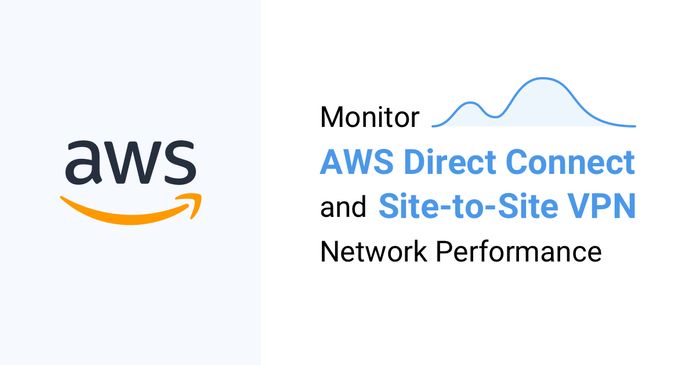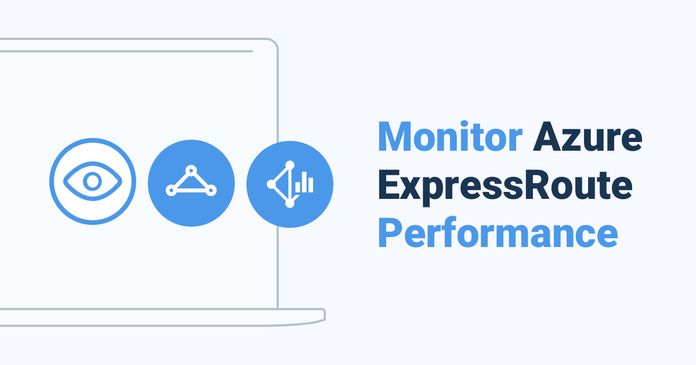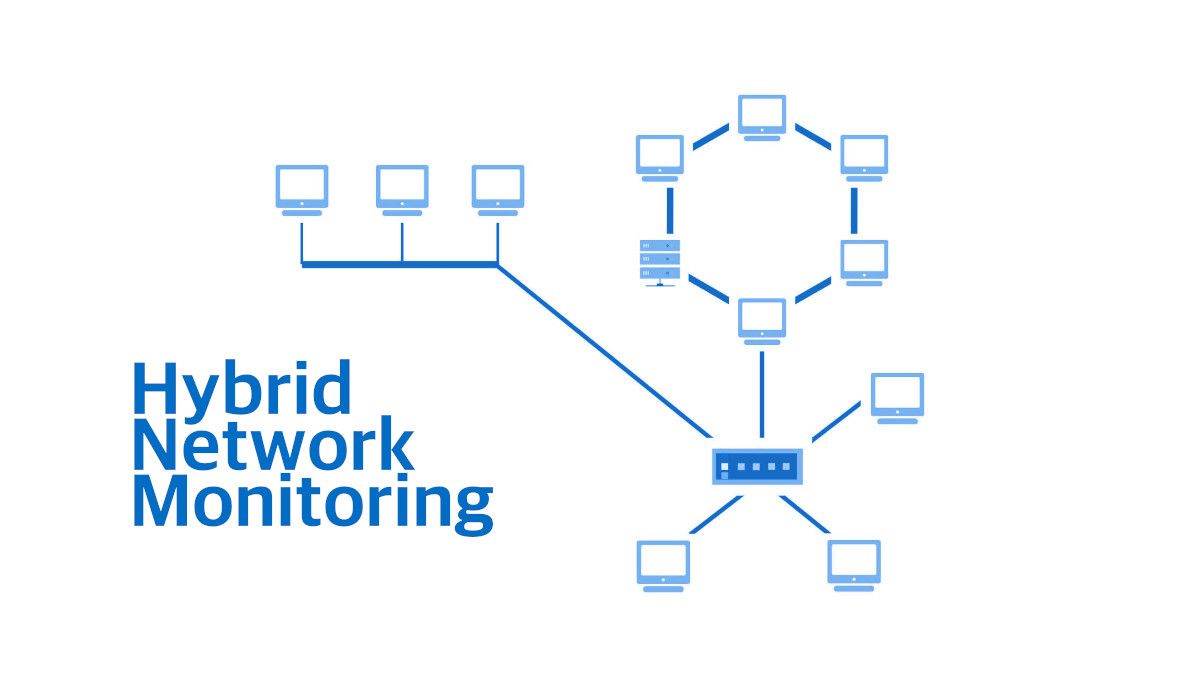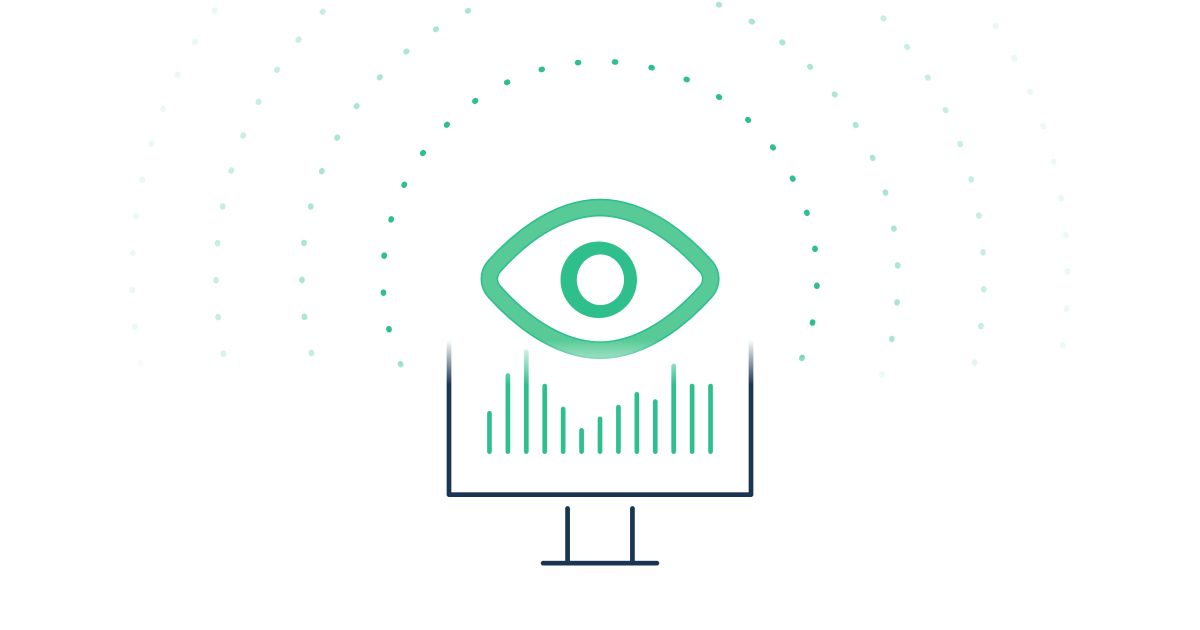Table of Contents
Table of Contents
Welcome to the world of cloud network monitoring, where invisible heroes work tirelessly behind the scenes to ensure a smooth and seamless cloud experience. Most businesses rely heavily on cloud computing - whether it’s AWS, Azure, or Google Cloud - so understanding the fundamentals of cloud network monitoring becomes essential to maintain sky-high network performance.
Imagine a cloud infrastructure as a bustling city, with countless virtual machines, containers, databases, and services interconnected like a complex web. Now, picture cloud network monitoring as the guardian angel overseeing this intricate network, vigilantly keeping an eye on its performance, availability, and security.
In this blog post, we will embark on an enlightening journey into the realm of cloud network monitoring for IT pros and network admins. We will demystify its inner workings, explore its critical role in optimizing network performance, and unveil how it safeguards your valuable data in the digital sky.
Cloud network monitoring is the practice of monitoring and managing the performance, availability, and security of network resources within a cloud computing environment. It involves the collection, analysis, and reporting of network-related data and metrics to ensure that the network infrastructure and services are operating optimally.
In a cloud environment, network monitoring is particularly important because the network serves as the backbone that connects various cloud components, including virtual machines, containers, storage systems, databases, and other resources. Cloud network monitoring allows organizations to gain visibility into the network infrastructure, detect potential issues or bottlenecks, and take proactive measures to maintain a high level of performance and reliability.


When it comes to cloud network monitoring, several key aspects take center stage. These aspects encompass performance monitoring, availability monitoring, security monitoring, traffic analysis, and alerting and reporting. By focusing on these critical elements, organizations can gain a comprehensive understanding of their network infrastructure and ensure optimal performance, robust security, and proactive issue resolution.
Key aspects of cloud network monitoring include:
- Performance Monitoring: Performance monitoring, or, more specifically, Network Performance Monitoring, involves tracking network metrics such as latency, bandwidth usage, packet loss, and throughput to ensure optimal performance. Monitoring tools collect and analyze this data to identify any performance bottlenecks or network congestion that might impact application performance.
- Availability Monitoring: More specifically called Network Availability Monitoring, is the practice of ensuring that the network infrastructure is available and accessible to users and applications. This involves monitoring network devices, links, and services to detect any downtime or outages and take appropriate actions to restore connectivity.
- Security Monitoring: Cloud network monitoring also includes monitoring for security threats and vulnerabilities within the network infrastructure. It involves detecting and responding to suspicious network activities, such as unauthorized access attempts, malware infections, or unusual traffic patterns that might indicate a cyber attack.
- Traffic Analysis: Monitoring tools capture and analyze network traffic data to gain insights into usage patterns, application behaviour, and user behaviour. This information can be used to optimize network resources, detect anomalies, and plan for capacity upgrades.
- Alerting and Reporting: Cloud network monitoring tools provide real-time network monitoring alerts and notifications to administrators or network operations teams when predefined thresholds or anomalies are detected. They also generate reports and visualizations to provide insights into network performance, trends, and compliance.
Overall, cloud network monitoring is crucial for maintaining the performance, availability, and security of cloud-based applications and services. It helps organizations proactively monitor their network infrastructure, troubleshoot issues, and ensure a seamless and reliable user experience.
Ready to unlock the superpowers of your network? Level up your monitoring game with Obkio! Keep your network flying high with real-time insights, proactive issue detection, and a user-friendly interface that's as smooth as butter.
Don't let network glitches rain on your parade, try Obkio today and watch your cloud network soar to new heights!

- 14-day free trial of all premium features
- Deploy in just 10 minutes
- Monitor performance in all key network locations
- Measure real-time network metrics
- Identify and troubleshoot live network problems

When it comes to monitoring the performance and health of a cloud network, various types of monitoring techniques can be employed. Each type offers unique insights and approaches to effectively analyze network data and understanding these monitoring methods equips organizations with the knowledge to select the most appropriate approach or combination thereof, based on their specific monitoring objectives, network infrastructure, and desired level of visibility.
Let's delve into the various types of cloud network monitoring and their respective benefits and applications:
Agent-based network monitoring involves installing software agents on various devices within the cloud network. These agents collect and send data regarding network performance metrics to a centralized monitoring system, like Obkio’s Network Performance Monitoring tool. This approach offers granular visibility into network performance, allowing for detailed analysis and troubleshooting. Agent-based monitoring is particularly useful for monitoring specific applications, servers, or virtual machines within the cloud environment.
Synthetic monitoring simulates network traffic and measures network performance by sending test packets or emulating user interactions. These tests help assess the availability, responsiveness, and performance of applications or services hosted in the cloud. Synthetic monitoring is commonly used to proactively monitor critical services, simulate user experiences, and validate service-level agreements (SLAs).
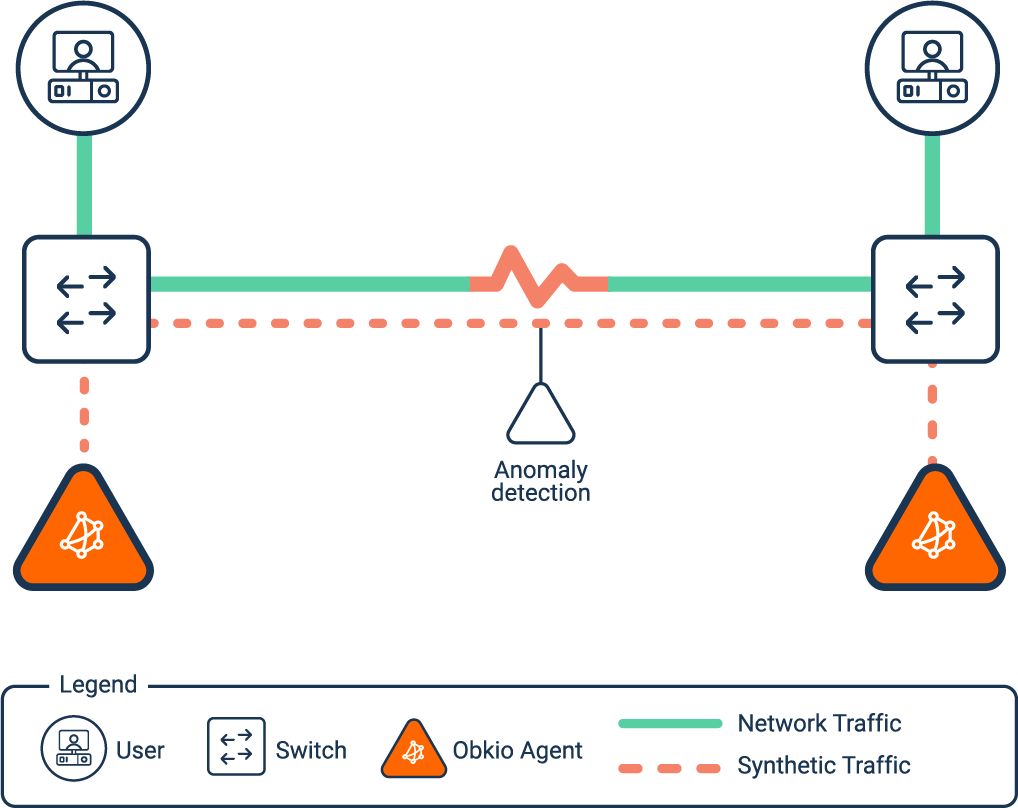
Flow-based monitoring captures network traffic flow data, such as NetFlow or sFlow, from network devices like routers or switches. Flow data includes information about the source and destination of traffic, protocols used, and packet counts. Analyzing flow data helps identify patterns, understand traffic behavior, and detect anomalies. Flow-based monitoring provides a high-level overview of network traffic and is useful for network capacity planning, security analysis, and performance optimization.
Packet-based monitoring involves capturing and analyzing individual network packets traversing the cloud network. This method provides the most detailed level of visibility into network performance, allowing for in-depth analysis of network protocols, latency, packet loss, and other performance metrics. Packet-based monitoring is useful for troubleshooting specific network issues, diagnosing network congestion (WAN or LAN congestion), and identifying the root cause of performance problems.
Each type of cloud network monitoring has its strengths and use cases. Organizations may choose to employ a combination of these monitoring types to gain comprehensive visibility into their cloud network's performance, security, and reliability. The selection of the appropriate monitoring type depends on specific monitoring goals, network infrastructure complexity, and the level of detail required for analysis and troubleshooting.
So you may be wondering, _“Ok great, but exactly do I monitor with this technique?” _Well as its name suggests, Cloud Network Monitoring monitors “cloud services and applications” and “networks” - that all of us use on a daily basis.
Cloud network monitoring can monitor various applications and services within a cloud computing environment. Some of the applications and services that can be monitored include:
These big players are probably names you’re very family with. Cloud network monitoring can include monitoring various services provided by major cloud providers like AWS (Amazon Web Services), Microsoft Azure, and Google Cloud. Here are some examples of services offered by these providers that can be monitored:
Cloud network monitoring can encompass monitoring services such as:
- AWS Direct Connect
- Amazon EC2 (Elastic Compute Cloud) instances
- Amazon RDS (Relational Database Service)
- Amazon S3 (Simple Storage Service)
- Amazon ELB (Elastic Load Balancer)
- Amazon VPC (Virtual Private Cloud)
- Zoom performance (since Zoom is hosted by AWS)
Monitoring these services ensures their availability, performance, and proper network configuration.
Azure offers a wide range of services that can be monitored, including
- Azure ExpressRoute
- Azure Virtual Machines
- Azure SQL Database, Azure Storage
- Azure Load Balancer, Azure Virtual Network
- Microsoft Teams monitoring
- Microsoft Dynamics 365 performance
Monitoring these services helps maintain network performance, detect potential issues, and ensure optimal connectivity within the Azure infrastructure. It can also be used for more general Microsoft network monitoring, for services and apps like Teams and Microsoft 365.
With Google Cloud, services like:
- Google Cloud Interconnect
- Google Compute Engine
- Google Cloud SQL, Google Cloud Storage
- Google Cloud Load Balancing
- Google Virtual Private Cloud can be monitored.
Monitoring these services enables efficient network resource utilization, identifies performance bottlenecks, and ensures reliable connectivity within the Google Cloud environment.
Virtual machines are widely used in cloud environments to host applications. Cloud network monitoring can monitor the network performance and traffic of individual VMs, ensuring they have sufficient bandwidth and identifying any network-related issues affecting their performance.
Containerization platforms like Docker and Kubernetes are popular for deploying and managing applications in the cloud. Network monitoring can track the network traffic and performance of containers, ensuring smooth communication between containers and identifying any network-related bottlenecks.
Load balancers distribute incoming network traffic across multiple servers or instances to improve performance and availability. Network monitoring can track the performance and health of load balancers, ensuring they are functioning properly and managing traffic efficiently.
Cloud-based databases are critical components of many applications. Monitoring their network connectivity and performance helps ensure efficient data transfer, query response times, and overall database availability.
Cloud network monitoring can monitor the network traffic and performance of web applications, ensuring they are responsive, delivering content efficiently, and identifying any network-related issues impacting user experience.
Cloud storage services, such as object storage or block storage, can be monitored to ensure data access, availability, and performance. Network monitoring helps detect any network latency or congestion affecting storage operations.
CDNs distribute content across geographically dispersed servers to improve content delivery speed. Network monitoring can track CDN performance, ensuring content is delivered efficiently and detecting any network-related issues affecting CDN performance.
Discover end-to-end Direct Connect Monitoring with Obkio! Identifying AWS network issues for seamless premise-to-cloud connectivity. Learn more!
Learn more

Cloud network monitoring brings a host of benefits to organizations relying on cloud computing. From enhancing performance and proactive issue detection to improving network security and optimizing resource allocation, the advantages are substantial.
Here are some key benefits:
- Enhanced Performance: By monitoring network metrics such as latency, bandwidth, and throughput, cloud network monitoring helps identify and address performance bottlenecks or congestion. This optimization leads to improved application responsiveness and a better user experience.
- Proactive Issue Detection: Cloud network monitoring allows for the proactive detection of network issues before they escalate into major problems. By setting up alerts and notifications for threshold breaches or anomalies, organizations can take timely action to resolve issues, reducing downtime and minimizing the impact on operations.
- Improved Network Security: Security monitoring within cloud network monitoring helps detect and respond to potential security threats. It enables the identification of unauthorized access attempts, malware infections, or unusual traffic patterns, allowing organizations to take immediate action to protect their network and data.
- Effective Capacity Planning: By analyzing network traffic and usage patterns, cloud network monitoring provides insights into resource utilization and helps in capacity planning. It enables organizations to anticipate future needs, allocate resources efficiently, and avoid performance degradation due to resource constraints.
- Better Resource Allocation: With cloud network monitoring, organizations can gain visibility into network usage and performance across different applications and services. This information helps in optimizing resource allocation, ensuring that network resources are appropriately provisioned and utilized to meet application demands.
- Cost Optimization: Cloud network monitoring can identify inefficiencies or unnecessary resource consumption, allowing organizations to optimize their cloud spending. By understanding actual network utilization and performance, organizations can right-size their cloud resources and avoid unnecessary costs.
- Compliance and Auditing: Monitoring network traffic and collecting data for auditing purposes is crucial for meeting compliance requirements. Cloud network monitoring helps in tracking and recording network activity, ensuring compliance with regulations and providing necessary documentation during audits.
- Centralized Network Management: Cloud network monitoring provides a centralized platform for network performance monitoring and network performance management of the network infrastructure across different cloud services and providers. It simplifies network management, reduces complexity, and improves operational efficiency.
Overall, cloud network monitoring offers numerous benefits, including improved performance, proactive issue detection, enhanced security, efficient resource allocation, cost optimization, compliance adherence, and centralized management. By leveraging these benefits, organizations can maximize the value and reliability of their cloud network infrastructure. Cloud cost optimization further ensures that organizations are efficiently managing their cloud expenses while maintaining performance and scalability.
When it comes to effectively monitoring and managing a complex cloud network, a dedicated network monitoring tool emerges as the ideal choice. While cloud providers offer some built-in monitoring capabilities, a specialized network monitoring tool offers a comprehensive and centralized solution tailored specifically for the unique challenges of cloud network monitoring.
Here’s how leveraging a dedicated Cloud network monitoring tool can empower organizations to gain complete visibility and control over their cloud network infrastructure.
There are many different Cloud Network Monitoring tools available, based on the needs of your business. But when it comes to ease of use, flexibility, and scalability, Obkio takes the cake.
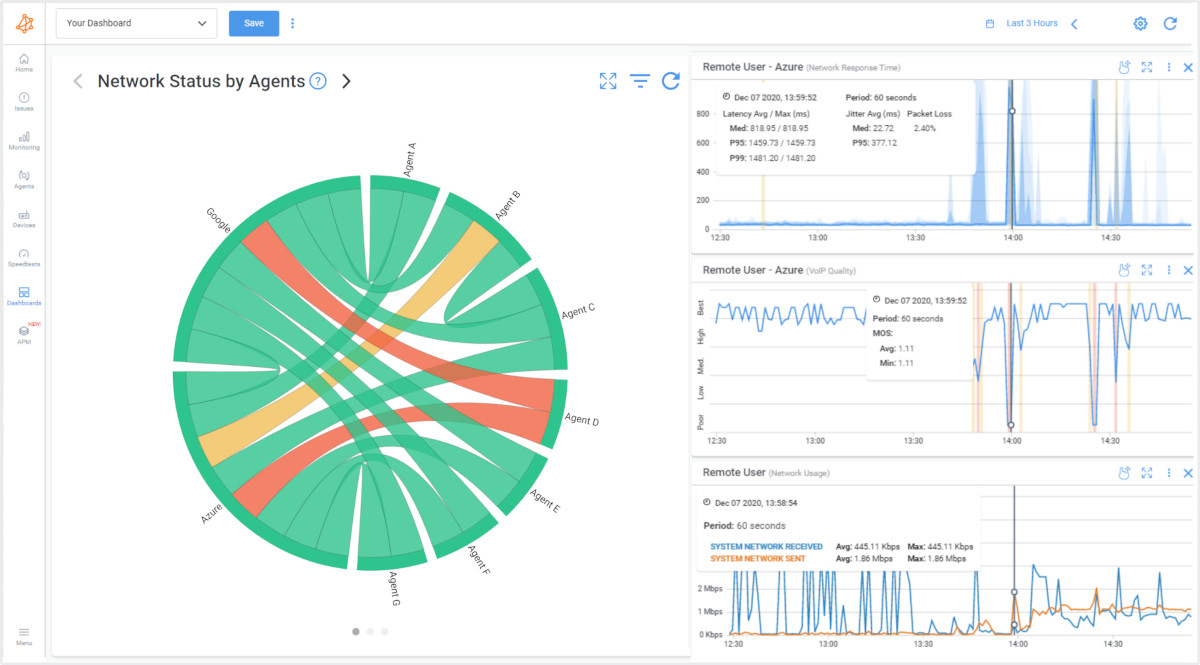
Obkio is a synthetic agent-based, cloud network performance monitoring tool that provides real-time monitoring and performance analytics for all network types, including cloud networks and services. With Obkio, you get a range of features for monitoring, assessing and troubleshooting cloud networks:
- Real-time Network Performance Monitoring: Obkio provides real-time monitoring of network performance, allowing you to track key metrics such as latency, packet loss, and bandwidth utilization.
- Proactive Issue Detection and Alerts: Obkio sends alerts and notifications when network performance thresholds are breached or anomalies are detected.
- User-Friendly Interface: Obkio offers a user-friendly interface that makes it easy to navigate, configure, and access network monitoring data.
- Multi-Cloud and Hybrid Environment Support: Obkio supports monitoring network performance across multi-cloud and hybrid network environments, allowing you to monitor and manage your network regardless of the cloud provider or infrastructure setup.
- Scalability and Flexibility: Obkio is designed to scale with your network infrastructure. It accommodates growing network environments and adapts to changing needs, making it suitable for organizations of all sizes.
- Historical Performance Data and Reporting: Obkio stores historical performance data, enabling you to analyze trends and patterns over time. It also generates comprehensive reports, allowing you to review and share network performance metrics with stakeholders.

To monitor end-to-end network performance you need to keep a watchful eye on every part of your network. That includes the WAN monitoring, LAN monitoring, or network devices. That's where the Network Monitoring Agents come in.
Obkio's Monitoring Agents are deployed at key network locations to continuously monitor performance between them. This includes your local network, your ISP network, and the Cloud. Here’s the setup you need.
- On-Premise Agent: First, you need to monitor your network performance. Deploy these Monitoring Agents in your local network, in key network locations like your head office, branch office, data centers and network devices. They allow you to monitor network performance from your end up to AWS. We recommend the Software (Linux, Windows, Docker) agent that can be installed on your favourite Linux distribution, including Amazon Linux and Amazon Linux 2.
- Public Monitoring Agents: These Agents are your Cloud network spies! Public Monitoring Agents are already installed and operated by either the Obkio team or service providers. They are perfect to monitor network performance up to public cloud and service providers without having to deploy any infrastructure. Choose the Public Monitoring Agents based on the Cloud service you want to monitor, such as:
- AWS Monitoring Agent: The AWS Monitoring Agent allows you to proactively monitor network performance between your local network to the AWS network. They provide complete and continuous visibility so you can easily identify the source and cause of AWS network issues impacting your network performance.
- Azure Monitoring Agent: The Azure Monitoring Agent allows you to proactively monitor network performance between your local network to the Microsoft Azure network. They provide complete and continuous visibility so you can easily identify the source and cause of Azure network issues impacting your network performance.
- The Google Cloud Agent: The Google Cloud Monitoring Agent allows you to proactively monitor network performance between your standard on-premise Agents and the Google Cloud Platform. With 360-degree visibility, you can easily identify the source and cause of network issues affecting Google Cloud Interconnect based on the monitoring data from these Monitoring Agents.
- Find all the Agents available in the Public Monitoring Agent Directory.
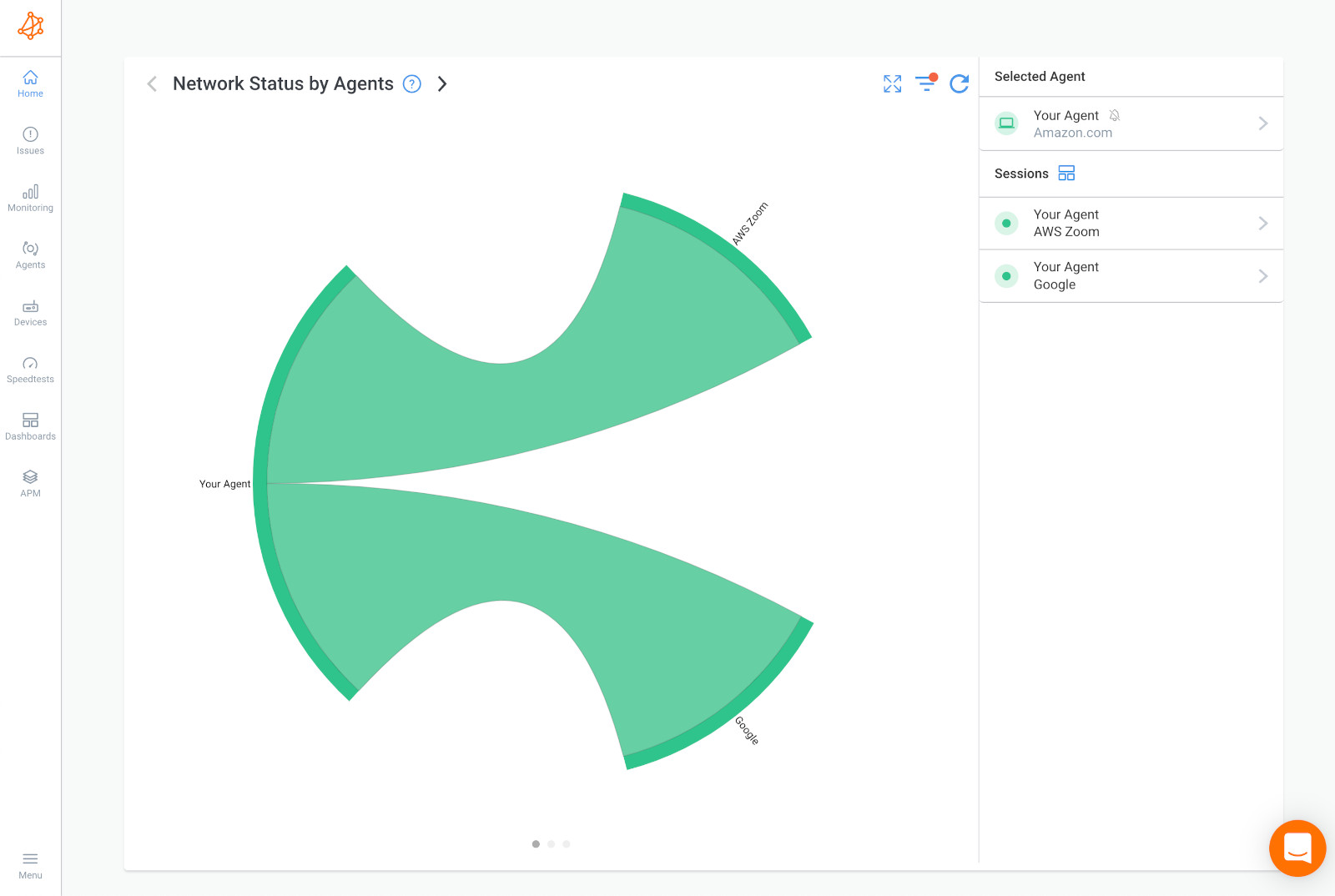
You need to deploy a minimum of more than two Agents to more accurately compare data between two points. For example: If you’re monitoring Google network performance between your Head Office and your Internet, deploy:
- One Agent in our Head Office
- And 2 Agents to monitor Internet performance and Internet problems (for example, a Google Cloud Agent and an AWS Agent).
With multiple Agents deployed, if you have a network problem, you can easily see if that same problem is affecting all your sites or just one.
Once the Monitoring Agents are installed, you're almost done! Two configurations are required in the App:
- The agents must be in the same Network. When two agents are in the same Network, they will communicate using private IPs instead of Public IPs.
- A Network Monitoring Template must be configured to create the network performance monitoring session.
Once the Monitoring Agents are deployed and configured, they will begin exchanging synthetic UDP traffic every 500ms to continuously measure Cloud network performance between your network and the cloud service.
That's all you need to do! Obkio will do the rest.
Your Monitoring Agents will now start sending synthetic packets to each other every 500ms to measure key network metrics affecting your network performance. This will give you an overview of your network performance and help you identify any issues that might be affecting your network or cloud service.
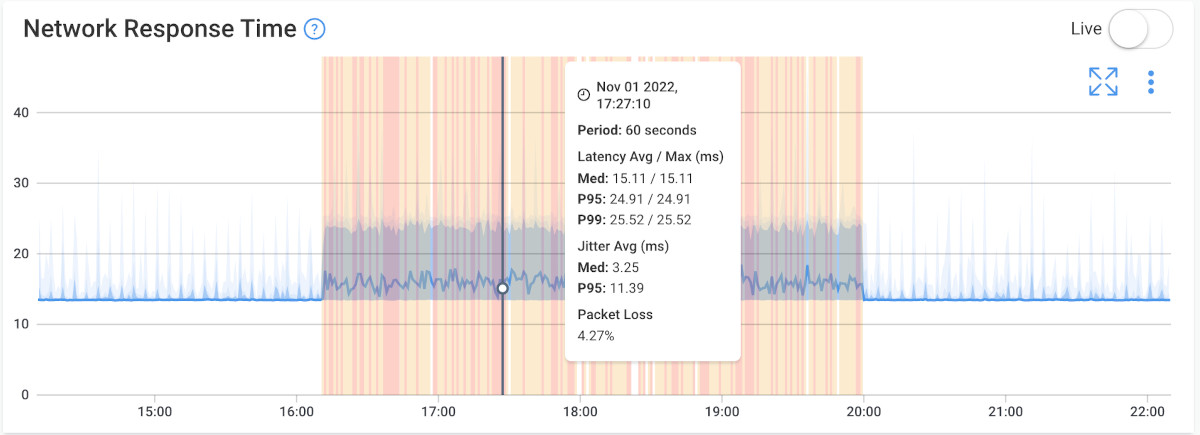
When it comes to cloud network monitoring, several key network metrics should be measured to gain insights into the performance, availability, and health of the network infrastructure. Here are some essential network metrics to consider:
- Latency: Latency measures the time it takes for data packets to travel from the source to the destination. Monitoring latency helps assess the responsiveness and performance of network connections, ensuring optimal application performance.
- Packet Loss: Packet loss refers to the percentage of data packets that are lost or dropped during transmission. Monitoring packet loss helps identify network congestion, faulty connections, or other issues that can affect data integrity and application performance.
- Bandwidth Utilization: Bandwidth utilization measures the amount of available network bandwidth or capacity being used at any given time. Monitoring bandwidth utilization helps identify potential bottlenecks, overutilization, or underutilization of network resources, ensuring efficient network performance.
- Throughput: Throughput represents the amount of data that can be transmitted over a network within a specific time period. Monitoring throughput helps evaluate the network's capacity to handle data transfer and identifies any limitations or performance issues.
- Jitter: Jitter measures the variation in latency or delay of network packets. It indicates the consistency of network performance and the stability of data transmission. Monitoring jitter helps identify network congestion, network equipment issues, or other factors that may impact data delivery.
- Network Availability: Network availability measures the percentage of time that the network is accessible and functioning correctly. Monitoring network availability helps identify periods of downtime, outages, or service disruptions, allowing for timely response and resolution.
- Error Rates: Error rates track the number of errors or anomalies encountered during network communication. Monitoring error rates helps identify network issues, faulty equipment, or configuration problems that may impact data integrity and application performance.
It's important to note that the specific network metrics to monitor may vary based on the unique requirements of your cloud network and the applications running on it. By measuring these network metrics, organizations can gain valuable insights into the health and performance of their cloud network, enabling proactive monitoring, troubleshooting, and optimization.


Monitoring network devices is a crucial element of cloud network monitoring that should not be overlooked. These devices, such as routers, switches, and firewalls, form the backbone of your network infrastructure and have a significant impact on the performance of your cloud services. Therefore, it is vital to include these critical components in your cloud network monitoring strategy to ensure optimal network performance and reliability.
Fortunately, Obkio has you covered with its Network Device Monitoring feature! By leveraging Ultra-Fast Polling at intervals as frequent as every 30 seconds, Obkio ensures vigilant monitoring of your network devices. This approach yields highly accurate results compared to traditional software polling, which typically occurs every 5 minutes. With this feature at your disposal, you can have peace of mind, knowing that your network devices are under constant surveillance, enabling swift detection of any issues that may arise.
For effective cloud network monitoring, it is essential to monitor various network devices that play a crucial role in the performance and security of your cloud network infrastructure. Here are some network devices that should be monitored:
- Routers: Routers are responsible for directing network traffic between different networks and ensuring data packets reach their intended destinations. Monitoring routers helps identify issues like network congestion, routing errors, or hardware malfunctions that can impact network performance.
- Switches: Switches facilitate the local network connections within a specific area or network segment. Monitoring switches helps detect connectivity issues, port errors, and network congestion, ensuring smooth communication between devices and optimal data transmission.
- Firewalls: Firewalls provide network security by controlling incoming and outgoing network traffic based on predetermined security rules. Monitoring firewalls helps identify unauthorized access attempts, detect security breaches, and ensure that firewall configurations are effective and up to date.
- Load Balancers: Load balancers distribute network traffic across multiple servers or instances to optimize performance and availability. Monitoring load balancers helps ensure proper load balancing, detects any imbalance or failure in distribution, and ensures consistent application delivery.
- Access Points: Access points enable wireless connectivity and provide network access to wireless devices. Monitoring access points helps ensure smooth wireless communication, detect signal strength issues, and identify potential security vulnerabilities in the wireless network.
- VPN Concentrators: VPN concentrators manage secure remote access to the cloud network by establishing encrypted connections. Monitoring VPN concentrators helps ensure their availability, track connection speeds, and identify any issues that may impact remote access to the cloud network.
- Network Security Appliances: Network security appliances, such as intrusion detection systems (IDS) and intrusion prevention systems (IPS), monitor network traffic for potential security threats. Monitoring these appliances helps detect and respond to security incidents, ensuring the integrity and confidentiality of network data.
Remember, the specific network devices to monitor may vary based on your cloud network architecture and the services deployed. It's important to consider the devices that are essential for network connectivity, security, and performance within your specific cloud environment.
With your cloud network monitoring in place using Obkio, you can now have peace of mind knowing that your cloud connections will remain stable and uninterrupted. Obkio's continuous monitoring ensures that any network outages are promptly detected, providing you with instant alerts within a matter of seconds. This empowers you to take immediate action, mitigating potential disruptions and network disconnections, and maintaining a seamless network experience.
Obkio's advanced time-travelling capabilities enable you to delve into historical network performance data, empowering you to analyze past issues and make informed decisions for enhancing your cloud connections in the future. It's akin to having a crystal-clear lens that offers insights into both the past and present of your cloud network!
With Obkio by your side, you can proactively address potential network issues and ensure consistent, optimal performance for your cloud network.
- Obkio's Traceroutes are also executed periodically in both directions to identify hop-by-hop issues and to keep track of the historical latency between hops.
- Schedule speedtests between the agents to monitor network speed and test the available throughput on the connection between the on-premise infrastructure and the Cloud.
Choosing the right cloud network monitoring solution is crucial for effectively managing and optimizing the performance of your cloud network infrastructure. Here are some factors to consider when selecting a suitable solution:
- Scalability: Look for a solution that can scale with your growing cloud infrastructure. As your network expands, the monitoring tool should have the capability to handle the increased traffic and monitor additional resources seamlessly. Ensure that the solution can accommodate your current and future network needs.
- Compatibility: Verify that the monitoring solution is compatible with your cloud environment. It should integrate smoothly with popular cloud service providers such as AWS, Microsoft Azure, and Google Cloud. This compatibility ensures seamless data collection and monitoring across your cloud resources.
- Real-time Monitoring: Opt for a solution that provides real-time monitoring capabilities. Real-time visibility allows you to promptly detect and address network issues as they occur. Look for features like instant alerts, customizable dashboards, and real-time data visualization to stay on top of your network's performance.
- Comprehensive Metrics: Ensure that the monitoring solution offers a wide range of network metrics to measure. This includes latency, packet loss, throughput, bandwidth utilization, and more. A comprehensive set of metrics enables in-depth analysis, troubleshooting, and optimization of your cloud network performance.
- Ease of Use: Choose a user-friendly monitoring solution that simplifies the monitoring process. The interface should be intuitive, allowing users to navigate easily and access key information effortlessly. Look for features like automated discovery of network devices, easy configuration, and intuitive reporting.
- Integration with Existing Tools: Consider whether the monitoring solution can integrate with your existing network management tools and systems. Integration allows for a unified monitoring and management experience, reducing complexity and streamlining your workflow. Look for support for common integration methods like APIs and SNMP Network Monitoring.
- Security: Network monitoring involves handling sensitive data, so security is paramount. Ensure that the monitoring solution offers robust security features, including encryption of data in transit and at rest, access controls, and compliance with relevant security standards. Protecting your network data is crucial to maintaining the integrity and confidentiality of your cloud environment.
- Support and Documentation: Evaluate the level of support and documentation provided by the monitoring solution vendor. Look for resources such as documentation, user guides, and a responsive support team that can assist you in setting up, configuring, and troubleshooting the monitoring solution.
By considering these factors, you can make an informed decision and choose a cloud network monitoring solution that aligns with your organization's needs, provides the necessary visibility into your cloud network infrastructure, and helps you optimize performance, ensure reliability, and deliver a superior user experience.


Integration with cloud providers is a crucial aspect to consider when choosing a cloud network monitoring solution. The ability of the monitoring tool to seamlessly integrate with popular cloud providers such as AWS, Microsoft Azure, and Google Cloud can significantly enhance the monitoring capabilities and efficiency of your cloud network infrastructure. Here are some key points to consider regarding integration with cloud providers:
- Native APIs: Look for a monitoring solution that provides native APIs (Application Programming Interfaces) for the cloud providers you use. Native APIs offer direct integration with the cloud provider's monitoring and management services, allowing for more accurate and detailed monitoring data. These APIs enable the monitoring solution to access vital metrics and data specific to your cloud resources, such as virtual machines, load balancers, storage, and databases.
- Automatic Discovery: The monitoring solution should have the ability to automatically discover and track the cloud resources in your environment. This eliminates the need for manual configuration and ensures that new resources are automatically monitored as they are added to your cloud infrastructure. Automatic discovery saves time, reduces errors, and provides comprehensive visibility into your cloud network.
- Tag-Based Monitoring: Cloud providers often allow users to assign tags to their cloud resources, which can be used for organizational and management purposes. A monitoring solution that supports tag-based monitoring enables you to define monitoring policies based on these tags. This flexibility allows you to easily monitor specific subsets of resources based on common attributes, such as application type, environment, or business unit.
- Cloud Provider-Specific Metrics: Different cloud providers offer unique sets of metrics and performance data for their services. Ensure that the monitoring solution can access and analyze the provider-specific metrics relevant to your cloud environment. This includes metrics related to compute instances, storage, networking, serverless functions, databases, and other cloud services. By capturing and analyzing these provider-specific metrics, you can gain deeper insights into the performance and health of your cloud resources.
- Cost Optimization: Integration with cloud providers can also help with cost optimization by monitoring resource utilization and identifying areas of inefficiency. The monitoring solution should provide insights into resource utilization, such as CPU usage, memory, and storage usage, enabling you to right-size your cloud infrastructure and avoid unnecessary costs. Integration with cost management tools provided by cloud providers can further enhance your ability to optimize spending.
- Multi-Cloud Support: If your organization utilizes multiple cloud providers or follows a multi-cloud strategy, consider a monitoring solution that supports integration with multiple cloud platforms. This ensures consistent monitoring and visibility across all your cloud environments, regardless of the provider. Monitoring tools with multi-cloud support enable centralized monitoring and management, simplifying operations and improving overall efficiency.
By choosing a monitoring solution that integrates seamlessly with your cloud providers, you can leverage the full capabilities of your cloud resources, gain comprehensive visibility into their performance, detect issues proactively, optimize resource utilization, and ultimately enhance the reliability and performance of your cloud network infrastructure.
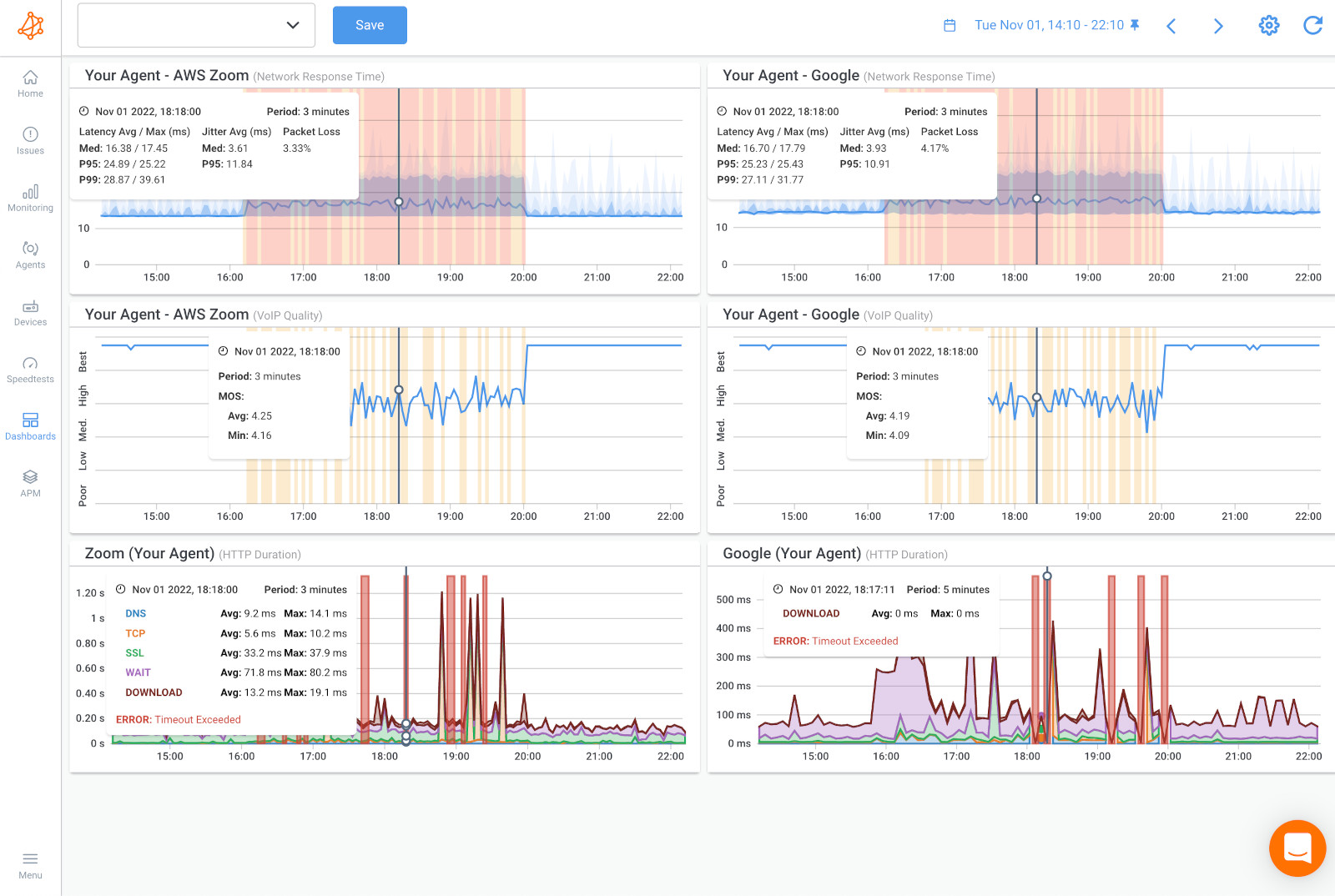
Level up your cloud network monitoring game with Obkio! Say goodbye to network hiccups and hello to smooth sailing in the cloud. Unleash the power of real-time monitoring, automated alerts, and crystal-clear network insights.

- 14-day free trial of all premium features
- Deploy in just 10 minutes
- Monitor performance in all key network locations
- Measure real-time network metrics
- Identify and troubleshoot live network problems
Don't let network issues rain on your cloud parade - join the Obkio revolution now!

Multi-cloud and hybrid environments have become increasingly common as organizations leverage the flexibility and advantages offered by different cloud providers and on-premises infrastructure. When choosing a cloud network monitoring solution, it's important to consider its ability to support such environments. Here are some key points to consider regarding multi-cloud and hybrid environment support:
- Multi-Cloud Visibility: A robust monitoring solution should provide comprehensive visibility into all your cloud environments, regardless of the cloud providers being used. It should offer seamless integration with multiple cloud platforms, such as AWS, Microsoft Azure (for Microsoft Cloud Monitoring), Google Cloud, and others. This allows you to monitor and manage your resources consistently across different clouds, ensuring a unified view of your network performance.
- Consistent Monitoring Policies: In a multi-cloud or hybrid environment, it's essential to have consistent monitoring policies and configurations across all cloud providers and on-premises infrastructure. The monitoring solution should provide centralized management, allowing you to define and apply monitoring policies consistently across various environments. This ensures that you can easily compare and analyze performance metrics across different clouds and maintain a unified monitoring strategy.
- Hybrid Network Monitoring: Hybrid environments often involve a combination of on-premises infrastructure and cloud resources. The monitoring solution should support monitoring across hybrid networks, enabling you to monitor network performance across your entire infrastructure. This includes monitoring network connectivity between on-premises and cloud resources, analyzing network traffic, and identifying performance bottlenecks or issues that span both environments.
- Inter-Cloud Dependency Monitoring: In a multi-cloud environment, applications and services may have dependencies that span across different cloud providers. The monitoring solution should be able to track and monitor these inter-cloud dependencies to ensure optimal performance. This involves monitoring network connectivity, latency, and data transfer between different clouds to identify any issues or bottlenecks affecting application performance.
- Seamless Data Correlation: When monitoring a hybrid environment or multiple cloud providers, it's crucial to have the ability to correlate data from different sources. The monitoring solution should provide mechanisms to collect, aggregate, and correlate data from various sources, including cloud provider APIs, on-premises monitoring tools, and other data streams. This allows you to gain a holistic view of your network performance, detect cross-environment issues, and perform in-depth analysis.
- Cross-Cloud Troubleshooting: When issues arise in a multi-cloud or hybrid environment, the monitoring solution should assist in troubleshooting by providing tools and insights to identify the root cause. This includes features like network topology mapping, packet capture analysis, and performance trend analysis across different clouds. The solution should facilitate quick and efficient troubleshooting, regardless of the cloud provider involved.
By selecting a monitoring solution that supports multi-cloud and hybrid environments, you can effectively manage and monitor your network performance across diverse infrastructure. This ensures consistent visibility, streamlined management, and optimized performance, regardless of the mix of cloud providers and on-premises resources in your environment.
Learn how to monitor network performance of Microsoft Azure ExpressRoute between your on-premise infrastructure, up to the Microsoft cloud.
Learn more

Before we send you off to fly high with cloud network monitoring, we're about to take your monitoring game to new heights and ensure your cloud network performance is as smooth as a summer breeze. Buckle up and discover the best practices for network cloud network monitoring to maximize efficiency, detect issues in a flash, and optimize your network like a pro.
Clearly define your monitoring objectives and what you aim to achieve with your cloud network monitoring strategy. Identify the key metrics, performance indicators, and thresholds that align with your business goals and requirements. This will help you focus on the most relevant data and avoid information overload.
Establish a network baseline using network metrics to understand what constitutes normal behaviour for your cloud network. This allows you to detect anomalies and deviations from the baseline, helping you identify potential issues or performance bottlenecks. Regularly review and update baselines as your network evolves over time.
Monitor network performance from end to end, encompassing both the cloud environment and the user experience. This includes monitoring latency, packet loss, bandwidth utilization, application response times, and other performance metrics. By monitoring end-to-end performance, you can identify and address issues impacting user satisfaction.
Leverage real-time monitoring capabilities to gain immediate visibility into your cloud network. Real-time monitoring allows you to detect and respond to network issues promptly, minimizing their impact on your services. It enables proactive troubleshooting, and faster incident response, and ensures optimal performance.
Configure automated alerts to notify you of any abnormal network behaviour or performance degradation. These alerts can be triggered based on predefined thresholds or specific conditions. By setting up automated alerts, you can be notified in real time when network issues arise, enabling you to take immediate action and minimize downtime.
Take advantage of cloud provider-specific metrics and monitoring tools provided by your cloud platform. These metrics can provide insights into the health and performance of your cloud resources. Monitor metrics related to computing instances, storage, networking, serverless functions, databases, and other cloud services to gain a comprehensive view of your cloud network.
Utilize network visualization tools and reporting capabilities provided by your monitoring solution. Visualizations such as dashboards, charts, and graphs can help you understand complex data and identify trends or patterns. Reports can provide a comprehensive overview of network performance, aiding in analysis, capacity planning, and decision-making.
Regularly review and analyze the monitoring data collected from your cloud network. Look for patterns, trends, and anomalies that could indicate network issues or performance bottlenecks. Perform root cause analysis to identify the underlying causes of any problems and take proactive measures to address them.
Use the insights gained from monitoring to continuously optimize your cloud network performance. Identify areas for improvement, such as optimizing network configurations, adjusting resource allocations, or implementing traffic management strategies. Regularly assess and refine your network architecture and configurations based on monitoring data and performance analysis.
Stay informed about emerging technologies, best practices, and industry trends in cloud network monitoring. Cloud environments and network technologies evolve rapidly, and staying updated will help you adapt your monitoring strategy to leverage new tools and techniques that enhance your network performance.
By following these network monitoring best practices, you can establish a robust cloud network monitoring approach that ensures optimal performance, minimizes downtime, and supports the seamless operation of your cloud services.


In the thrilling world of cloud network monitoring, the key to success lies in staying one step ahead of network gremlins and performance hiccups. With the power of best practices and the right monitoring tool, you can conquer any challenge that comes your way.
But why settle for anything less than extraordinary? That's where Obkio comes in!
With Obkio's cutting-edge features, intuitive interface, and real-time insights, you'll be the superhero of cloud network monitoring.
- 14-day free trial of all premium features
- Deploy in just 10 minutes
- Monitor performance in all key network locations
- Measure real-time network metrics
- Identify and troubleshoot live network problems

And say goodbye to uncertainty and hello to cloud domination!

You can rest assured that we're not like those pushy Sellsy people - there's no catch here. We firmly believe in the excellence of our product, but if it's not the right fit for you, we understand and want what's best for you.


























 Obkio Blog
Obkio Blog




